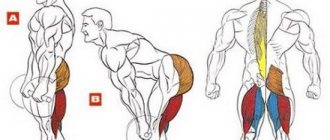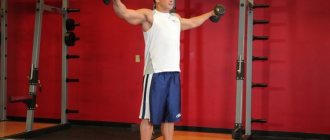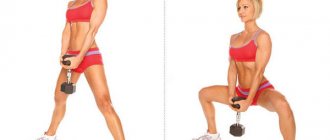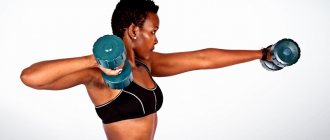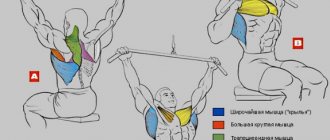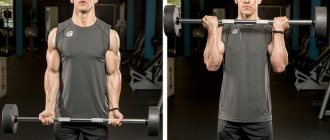Benefits of this exercise
Abductions with dumbbells will help you develop the shoulder girdle, increase the volume of your shoulders, and strengthen your joints, ligaments and tendons. All this will give your figure the correct “triangle” shape.
Standing dumbbell swings are an isolation exercise. When performed correctly, the main load goes to the middle bundle of the deltoid muscle. If done incorrectly, your triceps, front or rear deltoids, and trapezius will be involved in the work.
When performing it, you need to concentrate and pay attention to the correct execution.
Description of the exercise
It is better to bend your elbows a little. The less you jerk your shoulder blades, the better. The back should remain in place. The elbows at the top point “look” at the ceiling.
Main features
1. Can be done with one or two hands. Both sitting and standing. However, the slope should be close to parallel to the floor plane. But while sitting, you won’t be able to do such a tilt.
2. Your arms should be kept slightly bent at the elbows throughout the entire movement. In this case, ideally, the elbows should look up and not back. In this position, the rear delta is activated to its maximum.
3. Try not to squeeze your shoulder blades together to disable your back from working. To do this, raise your arms approximately so that your elbows are at the same height as your shoulders. But not higher.
4. The back should be straight. There is no need to slouch or sway your back. Remember, you need to lift the weight with muscle power, and not by inertia.
5. Bend your knees slightly. This will help arch your back and keep it straight.
6. Try to maintain the initial tilt of your back throughout the entire approach.
Correct technique
The most important rule for correctly performing this exercise is the starting position. Make smooth, slow movements, no need to jerk the dumbbells up.
I recommend performing shoulder raises after the basic bench press exercise.
- Starting position - shells in hands, feet shoulder-width apart and slightly bent at the knees. Place your body weight on your toes, keep your back straight, arms down. Stand in front of a mirror - this will help correct mistakes during the exercise.
- Hands are lowered along the hips with palms facing inward.
- Take a medium inhale and, as you exhale, slowly lift the dumbbells to the sides, to shoulder level or a little higher. Your arms can be slightly bent at the elbows.
- As you inhale, slowly lower the projectile down.
- Repeat the side swings in the same sequence again.
Depending on the position of your hands, you can pump up the middle, front or back buns.
So, we will start with the option when the middle deltas are loaded. In it (and in its variations), it is important not to take as much weight as possible, but to do the required number of repetitions so that the muscles literally “burn.” Therefore, in this case there is no need to chase heavy weights. Our goal is to pump up the deltoid muscles, saturate them with blood in order to achieve fiber ruptures. This is where growth can be expected.
You can also perform lifts with one hand - you need to lean on something with the other so as not to fall over.
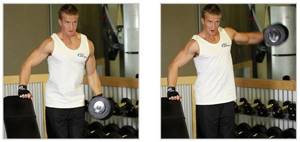
Swing dumbbells to the sides while standing
This exercise is designed to work out the relief of the middle beam of deltas . Although it is the smallest, it should never be neglected. If you pump only the front and rear delts, then you will have a depression between them. It looks very ugly. To prevent this from happening, you need to do dumbbell swings to the sides. Doing this exercise:
- Starting position: feet shoulder-width apart, back straight.
- At the bottom, your arms and shoulders are relaxed. Dumbbells are in your hands, at hip level.
- Smoothly raise your arms with dumbbells to the sides until your dumbbells are at shoulder level.
- At the top point you need to stay for 2 seconds.
- Slowly lower the dumbbells.
When performing this exercise, it is extremely important to feel a burning sensation in the muscles . When working the deltoid muscles, you should feel it in any case. If you don't feel a burning sensation, it means you're doing something wrong.
To avoid mistakes, you need to follow some rules:
- During the entire approach, your arms should be slightly bent at the elbow joint. This is necessary so that your forearms do not take the load that is intended for the deltoids.
- When performing the set, you need to concentrate on getting your elbows up. The movement should not be carried out due to the efforts of the biceps, but rather due to the lifting of the elbows upward. This is the only way you will feel the burning sensation in your muscles.
- The main thing in this exercise is the purity of execution. Under no circumstances should you violate the technique of performing this exercise. This will not only reduce the effectiveness of your workout, but also injure you.
- The weight of dumbbells should be light. This is to ensure that your reps are as clean as possible. This exercise should be performed in 3 sets of 15-20 repetitions. This is not a compound exercise, so heavy weights and low reps are not suitable.
- You should not start your delt training with this exercise. First of all, you need to perform basic movements. In our case, these are vertical barbell presses and rows to the chin.
There is another option for doing it - in a sitting position . You need to sit on a bench. Its tilt angle should be 90 degrees. Your back should rest firmly against the surface of the bench. This will help eliminate the back muscles from the load, and also reduce the risk of getting a back injury. This option is a little more complicated, but it will increase the effectiveness of your approach. There are situations when dumbbells with the weight you need are occupied. In this case, you can take lighter weights and swing with them while sitting on a bench.
As you might have guessed, you can do it not only to the sides. To shift the load to other deltas, you can raise your arms forward, or perform side raises in an inclined position.
For working out the front deltas, arm raises with dumbbells forward are suitable . The technique for performing this exercise is very simple, so for the purposes of our article, we will not touch it. But in the tilt, we will probably devote one section.
Various execution variations
If you have stagnation and your shoulders are not growing, then you should use other execution variations that load other delta bundles.
In front of
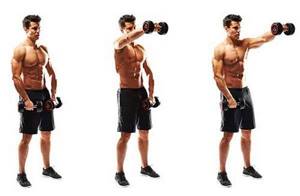
The principle is similar, only you lift the dumbbells forward, while your elbow should still be slightly bent and above the level of your hands. The front bundle of deltas is loaded. Do not pick up heavy equipment in your hands so as not to violate the correct technique.
You can perform it either one hand at a time, or with two hands, lifting them at the same time.
Bent over
In this case, you need to bend down, bend your lower back slightly, and keep your back straight. Hands in front of you with dumbbells, slightly bent at the elbows, palms facing each other. The principle of the spread is similar: the elbows are fixed, there is no need to raise them above the level of the shoulder girdle.
In this case, the rear delta bundle works.
Swings from a sitting position
The above exercises can also be done while sitting - in this case, pressing your back against the bench, you “turn off” your back muscles. We get insulation for a real “burn through” of the shoulders!
It is recommended to perform these swings only if you have sufficiently mastered the technique in a standing position. They can be performed either by pressing your back against the back of the bench, or by leaning forward (as in the standing version).
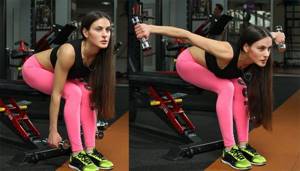
But the principle is the same:
- We hold the dumbbells with our hands on the sides of the body or in front of us if you are bent over;
- we spread our arms to the sides - the elbows are fixed and slightly bent, we do not raise them above shoulder level;
- At the top point we hold it for a couple of seconds and smoothly lower it.
The peculiarity of doing it while sitting is that you most likely will not be able to immediately take on the same working weight that was in a standing position. This is normal, because the muscles are isolated as much as possible.
Bent-over swings to the sides
This variation of dumbbell swings is great for working the rear deltoid muscles. He is actively involved in the work when doing back exercises. However, such a load is not enough to draw the relief. The rear deltoids are the most difficult to work out. This is where it is most difficult to feel the burning sensation during the exercise. Bent over exercises will help us solve this problem.
Exercise technique:
- Take dumbbells in your hands.
- Bend your torso forward 45 degrees.
- To avoid falling, rest your head against a wall or the back of an incline bench.
- Swing your arms.
- Make sure that the movement is carried out precisely by raising your elbows up.
- To prevent the biceps from taking the load, you must not bend your elbows.
- At the top point you need to linger for 2 seconds.
- You also need to lower the dumbbells smoothly. Under no circumstances should you throw them away.
If during the approach you still feel a burning sensation in your biceps, it’s okay. The main thing is that your delts also burn. If there is no burning, then you are doing something wrong. Ask a more experienced friend for advice. Perhaps they will point out your mistakes.
The back should be straight. If you round it, you will most likely get injured. Not all people can perform this exercise, since the elasticity of the lumbar muscles is different for everyone. If your lower back is not flexible enough, then you should replace this exercise by moving your arm back.
You should lean forward a little. The angle of inclination of the torso should be much less than in the version of this exercise that we discussed above. After this, you need to start moving your arms back. When you move your arms back, try to do it as high as possible. A very important point is that your arms should be slightly bent at the elbows. You cannot straighten them at the top point, otherwise the triceps will take almost the entire load.
There are no fundamental differences between these options. In both cases, the rear deltas are actively involved in the work. The main condition is a constant burning sensation in the muscles. If you feel it, don't stop. Try to speed up the pace. For a good workout of the rear deltas, three approaches of 15-20 repetitions will be enough.
Common Mistakes
There are two of them, but they reduce all the benefits to zero:
- An attempt to take more weight at the expense of technique - in our case there is no need to chase more weights. The main thing is the correct technique. And with large weights of dumbbells, athletes use jerks, swings or throws in order to lift the weight. It’s clear that the load on the necessary muscles decreases.
- Raising the elbows above the shoulders - the load ultimately goes to the trapezius muscles.
What should you remember about technology? We don’t raise our elbows above the shoulder girdle, we don’t chase heavy weights, we don’t throw dumbbells in jerks, “using” the back muscles. Isolate the movement as much as possible, feel that it is your shoulders that are working.
That's all for today. New records, friends!
Rules for performing dumbbell swings to the sides
1) At the beginning of the exercise, be sure to slightly bend your elbows, this will relieve the stress on your elbow joints. However, do not bend too much, otherwise you will take the payload from the side delta.
2) When at the top point, the dumbbells are spread to the side, the elbows should look back, but in no case down. The elbow should be at the same level as the raised dumbbell, not below it.
3) Don’t slouch, no matter when you lift or lower dumbbells, keep your back straight and your chest slightly protruding forward.
4) You can perform cheating and help yourself by lightly swinging your torso and throwing up the weight with your legs, but this should only be done in the last 2-3 repetitions and in the last 1-2 sets of raising dumbbells to the sides.
5) Lower the dumbbells in front near the groin, and not on the sides of the body, this will stretch the side deltoids more strongly. When the dumbbells have dropped down, do not let them hit each other, this removes the load and sets the initial movement due to the dumbbells bouncing off each other, and you need not how easier, but how best to load the middle bundle of the deltoid muscle.
6) When raising the dumbbells, they should be strictly to the sides, do not push your arms forward, it’s easier to do this, but the load also goes from the middle section of the shoulder to the front deltoid.
7) It is necessary to lift the dumbbells slightly above the shoulders, if below the load the shoulders will not receive the full load, if above the trapezius will take part of the load.



